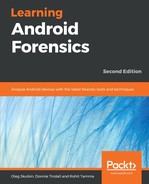Data present on an SD card can reveal lots of information that is useful during a forensic investigation. The fact that pictures, videos, voice recordings, and application data are stored on the SD card adds weight to this. As mentioned in the previous chapters, Android devices often use FAT32 or exFAT file systems on their SD card. The main reason for this is that these file systems are widely supported by most operating systems, including Windows, Linux, and macOS X. The maximum file size on a FAT32 formatted drive is around 4 GB. With increasingly high resolution formats now available, this limit is commonly reached, that's why newer devices support exFAT: this file system doesn't have such limitations. Recovering the data deleted from an external SD is pretty easy if it can be mounted as a drive.
If the SD card is removable, it can be mounted as a drive by connecting it to a computer using a card reader. Any files can be transferred to the SD card while it's mounted. Some of the older devices that use USB mass storage also mount the device to a drive when connected through a USB cable. As explained earlier, in forensics, in order to make sure that the original evidence is not modified, a physical image of the disk is taken and all further experimentation is done on the image itself. Similarly, in the case of SD card analysis, an image of the SD card needs to be taken. The process of imaging is similar to the one explained in Chapter 5, Extracting Data Physically from Android Devices. Once the imaging is done, we have a raw image file. In our example, we will use FTK Imager by AccessData, which is an imaging utility. In addition to creating disk images, it can also be used to explore the contents of a disk image.
The following are the steps that can be followed to recover the contents of an SD card using this tool:
- Start FTK Imager and click on File and then Add Evidence Item... in the menu, as shown in the following screenshot:

- Select Image File in the Select Source dialog and click on Next.
- In the Select File dialog, browse to the location where you downloaded the sdcard.dd file, select it, and click on Finish, as shown in the following screenshot:

- FTK Imager's default display will appear with the contents of the SD card visible in the View pane at the lower right. You can also click on the Properties tab below the lower left pane to view the properties for the disk image.
- Now, on the left pane, the drive has opened. You can open folders by clicking on the + sign. When highlighting the folder, contents are shown on the right pane. When a file is selected, its contents can be seen on the bottom pane.
- As shown in the following screenshot, the deleted files will have a red X over the icon derived from their file extension:

- As shown in the following screenshot, to export the file, right-click on the file that contains the picture and select Export Files...:

Sometimes, only a fragment of the file is recoverable, which cannot be read or viewed directly. In that case, we need to look through free or unallocated space for more data. Carving can be used to recover files from free and unallocated space. PhotoRec is one of the tools that can help you to do that. You will learn more about file carving with PhotoRec in the following sections.
